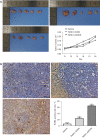Knockdown of tankyrase 1 inhibits the progression of gastric adenocarcinoma via regulating human telomerase reverse transcriptase and telomeric repeat binding factor 1
- PMID: 35557584
- PMCID: PMC9086053
- DOI: 10.21037/jgo-22-82
Knockdown of tankyrase 1 inhibits the progression of gastric adenocarcinoma via regulating human telomerase reverse transcriptase and telomeric repeat binding factor 1
Abstract
Background: Gastric cancer is one of the most lethal cancers. Aberrant expression levels of genes are frequently associated with cell immortalization and the occurrence of tumors. In this study, we aimed to investigate the role of tankyrase 1 (TANK1) in gastric adenocarcinoma and clarify the underlying mechanism.
Methods: The messenger RNA (mRNA) levels of TANK1, human telomerase reverse transcriptase (h-TERT), and telomeric repeat binding factor 1 (TRF1) in clinical specimens and SGC-7901 cells were measured via real-time quantitative polymerase chain reaction (RT-qPCR). Terminal deoxynucleotidyl transferase dUTP nick end labeling (TUNEL) and immunohistochemistry (IHC) assays were utilized to observe the cell apoptosis as well as Ki67 and h-TERT expression in tumor-bearing models. The effects of TANK1 antisense oligonucleotides (TANK1 ASODN) on viability and apoptosis of SGC 7901 cells were evaluated by cell counting kit-8 and flow cytometry analysis.
Results: We found that TANK1 and h-TERT were both increased in gastric adenocarcinoma, while TRF1 was decreased. Tumor-bearing models demonstrated that TANK1 ASODN appeared to be effective in inhibiting tumor growth and decreasing the expression of h-TERT. Additionally, TANK1 ASODN inhibited the viability and promoted apoptosis of SGC-7901 cells. Moreover, the mRNA levels of h-TERT and TRF1 were modulated by TANK1 ASODN.
Conclusions: This study revealed that TANK1 ASODN inhibits the proliferation and induced the apoptosis of gastric adenocarcinoma cells via manipulating the expression levels of h-TERT and TRF1.
Keywords: Tankyrase 1 (TANK1); gastric adenocarcinoma; human telomerase reverse transcriptase (h-TERT); telomeric repeat binding factor 1 (TRF1).
2022 Journal of Gastrointestinal Oncology. All rights reserved.
Conflict of interest statement
Conflicts of Interest: All authors have completed the ICMJE uniform disclosure form (available at https://jgo.amegroups.com/article/view/10.21037/jgo-22-82/coif). The authors have no conflicts of interest to declare.
Figures





Similar articles
-
[Preliminary research on the effect of antisense oligodeoxynucleotides of tankyrase 1 on tumor growth following intratumoral injection in mice].Zhonghua Jie He He Hu Xi Za Zhi. 2004 Sep;27(9):604-7. Zhonghua Jie He He Hu Xi Za Zhi. 2004. PMID: 15498272 Chinese.
-
Expression of telomeric repeat binding factor 1 and 2 and TRF1-interacting nuclear protein 2 in human gastric carcinomas.Int J Oncol. 2001 Sep;19(3):507-12. Int J Oncol. 2001. PMID: 11494028
-
Expression of MRE11 complex (MRE11, RAD50, NBS1) and hRap1 and its relation with telomere regulation, telomerase activity in human gastric carcinomas.Pathobiology. 2001;69(4):219-24. doi: 10.1159/000055946. Pathobiology. 2001. PMID: 12007281
-
Feedback regulation of telomerase reverse transcriptase: new insight into the evolving field of telomerase in cancer.Cell Signal. 2013 Dec;25(12):2462-8. doi: 10.1016/j.cellsig.2013.08.009. Epub 2013 Aug 29. Cell Signal. 2013. PMID: 23993966 Review.
-
[Telomerase, cell immortality and cancer].Hokkaido Igaku Zasshi. 2001 May;76(3):127-32. Hokkaido Igaku Zasshi. 2001. PMID: 11481865 Review. Japanese.
References
LinkOut - more resources
Full Text Sources
